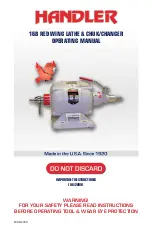Summary of Contents for Craftsman 101.07403
Page 10: ... Part I LATHE CARE AND CONSTRUCTION c I C I z ca C C r ...
Page 43: ... r CIC CIC I CI 111 111 l 111 ...
Page 57: ... J J J J Part 4 THE MACHINING OF VARIOUS MATERIALS u I C r z en C z ...
Page 79: ... 1r 1 ...
Page 80: ... J J J J J J J J I j Part 5 HOLDING THE WORK Cl I I a rn z en cc I C a z z en I a I 4 I ...
Page 95: ... J J J J J J Part 6 DRILLING AND BORING I a l l I z I ill 11 11 l l I ...
Page 107: ... L l ...
Page 136: ......
Page 148: ... ...
Page 170: ......
Page 191: ... I J J J 7 Part 8 LATHE ATTACHMENTS AND THEIR USES cc e CJ t z z c I rn en z en ...
Page 227: ...r7 I I _I I I ...
Page 228: ... J l 7 7 J J Part 9 WOODTURNING ON THE METAL LATHE cc I e c c z z c c I CICI m en ...
Page 249: ...J J J J J J J J J J J J J 7 _J J Part 10 MACHINISTS TABLES I CD r m en I z c t m I ...
Page 265: ... 11 11 ...
Page 266: ... J 7 1 7 l Part 11 INDEX ...
Page 270: ......
Page 271: ... _ I r c r C _ _ Part 12 PAGES FOR YOUR SHOP NOTES t I z c t en ...


























